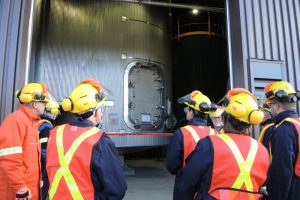This text is a reproduction of an article by Sarah-Ève Charland published in the online edition of the newspaper Les 2 Rives de Sorel-Tracy. The CTTÉI is at the origin of this initiative. The CTTÉI validated that the physico-chemical properties of the SO2 residue met the acceptance criteria for Agro-100. The two companies were then put in contact.
Rio Tinto's SO2 residue will be recovered to create fertilizer material

Photo credit : Les 2 Rives
Rio Tinto Fer et Titane's (RTFT) sulphur dioxide (SO2) recovery plant tailings will be upgraded through an agreement with Agro-100. This is the result of a concerted effort to reduce the environmental footprint and promote sustainable development. The SO2 recovery plant was inaugurated in 2014, but was fully launched in 2015. It reduces SO2 emissions. SO2 emissions are recovered and reacted with hydrated lime.
Read the original article here.
